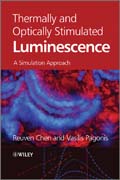
Thermally and optically stimulated luminescence: a simulation approach
Chen, Reuven
Pagonis, Vasilis
The emphasis in the present book will be on results that one can get from simulations, which can add a new dimension to results from theoretical considerations mainly based on simplifying assumptions. Chapter 1 will introduce both techniques. Thermoluminescence, methods for evaluating trapping parameters and additional phenomena of TL will be featured in Chapters 2 to Chapter 4. Optically stimulated luminescence (OSL) will be discussed in Chapter 5 and the n the next chapters will detail analytical and approximate expressions of dose dependence of TL and OSL and simulations of TL and OSL in dating and dosimetry procedures. Chapters 8 and 9 will detail the pre-dose (sensitization) effect and simultaneous measurements. Chapters 10 to 13 will focus on applications in medical physics, radiophotoluminescence, quantum-mechanical basis of TL and OSL and the exponential integral. The book will conclude with the appendix and the bibliography. INDICE: PREFACE. Chapter 1. Introduction. 1.1. The Physical mechanism of TL and OSL phenomena. 1.2. Historical development of TL and OSL dosimetry. 1.3.Historical development of luminescence models. Chapter 2. Theoretical Basis of Luminescence Phenomena. 2.1. Energy Bands and Energy Levels in Crystals. 2.2. Trapping Parameters Associated with Impurities in Crystals. 2.3. Capture Rate Constants. 2.4. Thermal Equilibrium. 2.5. Detailed Balance. 2.6. Arrhenius Model. 2.7. Rate Equations in the Theory of Luminescence. 2.8. Radiative Emission and Absorption. 2.9. Mechanisms of thermal quenching in dosimetric materials. 2.10. A kinetic model for the Mott-Seitz mechanism in quartz. 2.11. The thermal quenching model for alumina by Nikiforov et al. Chapter 3. Basic Experimental Measurements. 3.1. General approach to TL and OSL phenomena. 3.2. Excitation spectra. 3.3. Emission spectra. 3.4. Bleaching of thermoluminescence and OSL. Chapter 4. Thermoluminescence: The Equations Governing a TL Peak. 4.1. Governing equations. 4.2. One trap-one recombination center (OTOR) model. 4.3. General-order kinetics. 4.4. Mixed-order kinetics. 4.5. Q- and P-functionsQ- andP-functions. 4.6. Localized transitions. 4.7. Semilocalized (SLT) models of thermoluminescence. Chapter 5. Basic Methods for Evaluating Trapping Parameters. 5.1. The initial-rise method. 5.2. Peak-shape methods. 5.3. Methods of various heating rates. 5.4. Curve _tting. 5.5. Developing equations for evaluating glow parameters. 5.6. The photoionization cross section. Chapter 6. AdditionalPhenomena associated with TL. 6.1. Phosphorescence decay. 6.2. Isothermal decay of TL peaks. 6.3. Anomalous fading and anomalous trapping parameters of TL.6.4. Competition between excitation and bleaching of TL. 6.5. A model for mid-term fading in TL dating; continuum of traps. 6.6. Photo-transferred thermoluminescence (PTTL). 6.7. TL-response of Al2O3 : C to UV-illumination. 6.8. Dependence of the TL excitation on absorption coe_cient. 6.9. TL vs. impurity concentration; concentration quenching. 6.10. Creation and stabilization of TL traps during irradiation. 6.11. Duplicitous TL peak due to release of electrons and holes. 6.12. Simulations of the duplicitous TL peak. Chapter 7. Optically Stimulated Luminescence (OSL). 7.1. Basic concepts of optically stimulated luminescence (OSL). 7.2. Dose dependence of OSL; basic considerations. 7.3. Numerical results of OSL dose dependence. 7.4. Simulation of the dose-rate dependence of OSL. 7.5. The role of retrapping in the dose dependence of pulsed OSL. 7.6. Linear-modulation OSL (LM-OSL). 7.7. Uni_ed presentation of TL, phosphorescence (PL) and LM-OSL. 7.8. The new presentation of LM-OSL within the OTOR model. 7.9. TL-like presentation of CW-OSL in the OTOR model. 7.10. Dependence of luminescence on initial occupancy; OTOR model. 7.11. TL expression within the uni_ed presentation. 7.12. Pseudo LM-OSL and OSL signals under various stimulation modes. 7.13. OSL decay and s
- ISBN: 978-0-470-74927-2
- Editorial: John Wiley & Sons
- Encuadernacion: Cartoné
- Páginas: 440
- Fecha Publicación: 01/04/2011
- Nº Volúmenes: 1
- Idioma: Inglés
